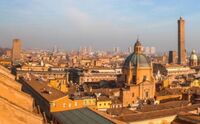| Country | Istalia |
| Region | Trivendito |
| Government | Mayor–council |
| Governing body | City Council |
| Mayor (Sindaco) | |
| Ruling party(s) | |
| Area | 72 km² |
| Population | 2,680,945 |
Burìa, previously known as Bunogna, is a city of the Istaliaian region of Trivendito. It is an important industrial hub as well as cultural and research center, renowned for its university which is the most ancient universiy in Istalia, founded in 1147.
History[]
Ancient and Modern Times[]
Burìa rises on the site of an ancient Therak civilization which flourished thanks to the fertile lands around the River Acquechiare. The most ancient archeological testimoniances show that the city increased its power also as religious center but when the city was conquered by the Kingdom of Qolshamih, it was totally destroyed and a new town was founded on the site only around the end of 2nd century BC.
After the fall of the Kingdom of Qolshamin, on the site the warlords controlling the area built a large fortress which however was conquered several times during the numberous wars and klashes of the following centuries. The establishment in the city of a large Hosian monastery around 5th century, however, contributed to make the city an important cultural center during the dark ages and which flurished also under the Augustan Dominion of the late medieval period. Here a large library was established by the Augustan Patriarch of the East, trusting the monks of the monastery to preserve it, realizing copies to send all over the empire, spreading the ancient knowledges of one of the cradle of the civilization. All this lead in 1147 to the foundation in the city of the first university of the Estalian lands, promoted and funded by the Hosian Church.
After the retirement of the Augustan forces, Burìa fell under the control of Padua, one of the famous Trading cities of the second half of the first millennia. Padua leaders continued to promote Burìa as cultural center while some ante-litteram mecenate tried to collect in the city many remains of the ancient times. For this reason during the Renascentia many artists and schoolars reached Burìa to study ancient texts and to see the testimoniancies of the ancient eras.
The city suffered a lot, instead, under the Ahmadi Caliphate which leaders, warlords and soldiers, lead by religious fanatism, persecuted and destroyed most part of the past testimoniances. Famous is the destruction of the monastery and its library and the almost destruction of the annexed university which, however, was turn an Ahmadi Religious University.
The Kingdom of Fidelia, retaking the city from the Ahmadi conquerors, invested then a lot to make recover Burìa as cultural istalian center and, closed the Ahmadi university, a new one was founded, the same which lasted until today.
Contemporary era[]
In contemporary era, Burìa began to grow also as industrial hub, especially under the Union of Quanzari Soviets, with the establishment along the river Acquechiare of many heavy industry facilities. This increased so much the population, expecially the working-class population, that the Soviets authorities was forced to promote the construction of the largest popular quartiers in Istalia, which became within the collective culture one of the most degradated places in Istalia, although a lot of requalification programs tried to cope with the situation.

View of the Burìa Technocitadel
Burìa today is a city made of great contradiction, with many students as well as workers, making the city a traditionally bastion of leftist parties during the long contemporary history of Istalia and since the first half of 51th century the city came back to be a cultural and scientific hub for the country when large portion of a dismised and degradated industrial area was turned in the so called Technocitadel, a citadel of data, science and innovation that became a technological, scientific and research hub in the fields of energy, new technologies, the environment, industry 4.0 and big data offering spaces for public and university research institutes, providing thousands of square meters of laboratories equipped with the latest generation instrumentation and unprecedented research infrastructures, as well as for companies with particular attention to new start-ups. The key structure within the Technocitadel were the "South-Eastern Majatran Great Data Center", at the time the largest and most powerful infrastructure of its kind in the entire continent, and the "Riccardo" Supercomputer, named after the Renascentia genius Riccardo da Assise, dedicated to high-performance scientific computing and made available to public, private and scientific projects of all kinds.
Administration[]
Government[]
The local form of government of the city follow the model of the mayor–council government system, with a mayor (Istalian: Sindaco) elected by voters, and a unicameral council as the legislative branch (Fidelian: Consiglio). To the mayor is given almost total administrative authority and a clear, wide range of political independence, with the power to appoint and dismiss department heads and furthermore he prepares and administers the city budget, although most part of the decisions must be approved by the council.
Notable citizens[]
- Emanuele Mantovani (National Conservative Party), former mayor (4606-4610)
- Enrico Dosio (SE), mayor (4860-)


